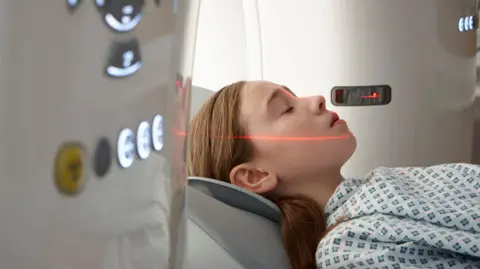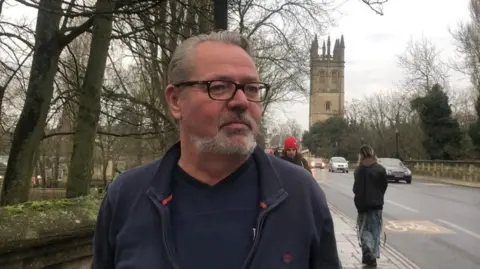[ad_1]
 Getty Photographs
Getty PhotographsThat is the sixth function in a six-part sequence that’s taking a look at how AI is altering medical analysis and coverings.
When 58-year-old Will Studholme ended up in accident and emergency at an NHS hospital in Oxford in 2023 with gastrointestinal signs, he wasn’t anticipating a analysis of osteoporosis.
The illness, strongly related to age, causes bones to change into weak and fragile, rising the chance of fracture.
It turned out that Mr Studholme had a extreme case of meals poisoning, however early in his ailment’s investigation, he obtained an belly CT scan.
That scan was then later run via synthetic intelligence (AI) expertise which recognized a collapsed vertebra in Mr Studholme’s backbone, a typical early indicator of osteoporosis.
Additional testing ensued, and Mr Studholme emerged not solely together with his analysis, however a easy remedy: an annual infusion of an osteoporosis drug that’s anticipated to enhance his bone density.
“I really feel very fortunate,” says Mr Studholme, “I do not suppose this may have been picked up with out the AI expertise.”
 Will Studholme
Will StudholmeIt is not remarkable {that a} radiologist may word one thing incidental in a affected person’s imaging – an undetected tumour, a priority with a specific tissue or organ – outdoors of what that they had initially been checking for.
However making use of AI within the background to systematically comb via scans and robotically establish early indicators of frequent preventable power ailments that is likely to be brewing – whatever the cause the scan was initially ordered – is new.
The scientific use of AI for opportunistic screening or opportunistic imaging, as it’s known as, “is simply starting” notes Perry Pickhardt, a professor of radiology and medical physics on the College of Winconsin-Madison, who’s amongst these creating the algorithms.
It’s thought-about opportunistic as a result of it takes benefit of imaging that has already been executed for one more scientific objective – be it suspected most cancers, chest an infection, appendicitis or stomach ache.
It has the potential to catch beforehand undiagnosed ailments within the early phases, earlier than onset of signs, when they’re simpler to deal with or forestall from progressing. “We will keep away from loads of the shortage of prevention that we have now missed out on beforehand,” says Prof Pickhardt.
Common physicals or blood checks usually fail to select up these ailments, he provides.
 Getty Photographs
Getty PhotographsThere’s loads of knowledge in CT scans associated to physique tissues and organs that we do not actually use, notes Miriam Bredella, a radiologist at NYU Langone who can be creating algorithms within the discipline.
And whereas evaluation of it may theoretically be executed with out AI by radiologists making measurements – it will be time consuming.
There are additionally advantages of the expertise by way of decreasing bias, she notes.
A illness like osteoporosis, for instance, is considered largely affecting skinny, aged white ladies – so medical doctors do not all the time suppose to look outdoors of that inhabitants.
Opportunistic imaging, alternatively, does not discriminate that manner.
Mr Studholme’s case is an effective instance. Being comparatively younger for osteoporosis, male and with no historical past of damaged bones, it’s unlikely he would have been recognized with out AI.
Along with osteoporosis, AI is being educated to assist opportunistically establish coronary heart illness, fatty liver illness, age-related muscle loss and diabetes.
Whereas the primary focus is on CT scans, for instance of the stomach or chest, work is happening to opportunistically glean data from different sorts of imaging too, together with chest x-rays and mammograms.
The algorithms are educated on many 1000’s of tagged earlier scans, and it’s important the coaching knowledge consists of scans from a large swathe of ethnic teams if the expertise goes to be deployed on a various vary of individuals, stress the consultants.
And there may be speculated to be a degree of human assessment – if the AI finds one thing suspect it will be despatched to radiologists to substantiate earlier than it’s then reported on to medical doctors.

The AI expertise used to look at Mr Studholme’s scan belongs to Israeli firm Nanox.AI, which is certainly one of solely a handful of firms engaged on AI for opportunistic screening – way more are centered on utilizing AI to help within the correct and swift diagnoses of the precise circumstances the scans are literally performed for.
Nanox.AI affords three opportunistic screening merchandise aimed toward serving to establish osteoporosis, coronary heart illness and fatty liver illness respectively from routine CT scans.
Oxford NHS hospitals started trialling Nanox.AI’s osteoporosis centered product in 2018 earlier than formally rolling it out in 2020.
Outcomes from Oxford hospitals present an as much as six-fold enhance above the NHS common within the variety of sufferers being recognized with vertebral fractures – sufferers that may then be checked for osteoporosis, and begin remedy to fight the illness, says Kassim Javaid, a professor of osteoporosis and uncommon bone ailments on the College of Oxford who has spearheaded the algorithm’s introduction.
Additional trials of the algorithm are additionally now underway at hospitals in Cambridge, Cardiff, Nottingham and Southampton. “We need to construct the proof to make use of it throughout the NHS,” says Prof Javaid.
But whereas the expertise can profit people, there are wider ramifications that should be thought-about says Sebastien Ourselin, a professor of healthcare engineering at Kings School London, who heads the AI Centre for Worth Primarily based Healthcare.
A giant drawback that must be balanced, he notes, is the additional affected person numbers that the usage of the expertise can create. “That is rising the demand on the healthcare system not decreasing it,” he says.
First, people who find themselves flagged by the opportunistic screening as doubtlessly having a illness will doubtless want additional confirmatory testing, which takes assets. And, if the AI is inaccurate or too delicate, that might end in loads of pointless testing.
Then providers should be in place for these further people who do find yourself being recognized.
The additional load is a problem that comes with the expertise admits Prof Javaid – however there are answers.
Sufferers confirmed to have the fractures in Oxford are routed for observe as much as a largely nurse delivered fracture prevention service in order to not overload medical doctors. “The AI does drive you to vary your pathway,” he says.
And in the long term, believes Prof Javaid, to have a larger variety of folks with early-stage osteoporosis recognized and receiving the preventative remedy they want will save the NHS cash. “Fracture is among the prime causes folks find yourself in hospital,” he says.
Mr Studholme has seen the devastation of osteoporosis first hand: it led to his mom breaking each her hips. It used to simply be thought-about an previous individual’s situation with nothing that could possibly be executed, he says. “I really feel fairly privileged I can do one thing earlier than my bones flip into chalk,” he says.
[ad_2]
[ad_1]
#spot #ailments #medical doctors #arent
[ad_2]
, 2025-01-17 00:07:00


